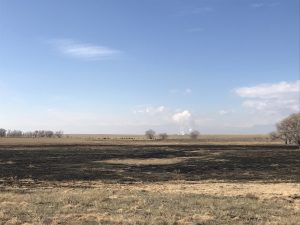DENVER –This wildlife refuge along Colorado’s Front Range just north of Denver is an emerging oasis for black footed ferrets and bison where rangers also promote conservation to children.
The 15,000-acre refuge once was home to a chemical weapons factory in WWII. Later shell leased the land and produced pesticides including DDT. Then in the Cold War, the army produced nerve agent called sarin, a deadly gas. The place became an environmental disaster. By 1987, a $2.1 billion federal cleanup had begun. By 2012, 10,000 acres were fully restored.
“You win a lot you lose some, it’s a big chess game,” said David Lucas Refuge Manager for the U.S. Fish and Wildlife Service.
With 98% of their habitat destroyed the refuge is home to around 70 black footed ferrets which is 1/3 of the world’s population. They are all wild born. Officials have set aside 3,000 acres for prairie dogs. Black footed ferrets and prairie dogs are codependent, on average a black footed ferret will consume a prairie dog every three days.
Workers at the wildlife refuge have embarked on an $875,000 prairie dog vaccination program to prevent a sylvatic plague, similar to the black plague. The vaccines contain blue ink. Rangers can assess whether prairie dogs are ingesting the vaccine by inspecting the feces which turns bright blue. “It’s all about risk reduction,” said Lucas.
Each year, refuge workers deliberately burn 20 percent of the refuge, simulating natural processes to spur growth of native short grass prairie.
Refuge crews are working to eradicate invasive vegetation like cheat grass, “If we see a lot of bull frogs, we are going to go kill them,” Lucas said. Time is of the essence, managers at the refuge work hard to be proactive when there is a problem, especially with invasive species.
About 180 bison roam across this refuge. The herd is brucellosis free, he said, referring to a bovine disease. He says they are genetically robust each year 12 bison move to Native American tribal sites. None of their bison are harvested for meat.
At the refuge this week, a whitetail deer buck walked at the base of trees, head down sniffing for females up ahead. Mule deer, too, calmly grazed along a road, seemingly undisturbed by cars. In a marsh surrounded by cattails, waterfowl fed. Hooded mergansers ducks. Ring necks. Canada geese.
Refuge biologists and rangers essentially are putting together the ecosystem equivalent of a puzzle, bringing together wildlife and plants one by one.
Expanding human developments surround the refuge. The Denver Internation Airport sits to the east. Jets swoop over the refuge. To the southwest, a cluster of high-rise buildings in downtown Denver shoots skyward.
The impact on wildlife seems minimal, Lucas said.
More and more people are visiting. In 2018, more than 450,000 people showed up. By 2020, refuge officials project 1 million visitors. More women are getting involved in conservation. The visitors are racially, ethnically and culturally diverse coming from all over the world.
“We are here to connect the next generation with conservation,” said Lucas.
Managing this refuge so that wildlife and the land aren’t destroyed while also allowing many more people means making tradeoffs.
Would it be worth it to sacrifice to accommodate more people? Lucas argued yes. Refuge managers are trying to concentrate visitation 4,000 acres at the southern part of the refuge, while prioritizing wildlife in the north.
The refuge may be a relatively small landscape in the West. But it gives city dwelling people the opportunity to observe the beauty of what the Front Range used to be.

A recent prescribed burn blackened soil where bison graze as a metro Denver powerplant generates electricity. PHOTO Rhett Turner

